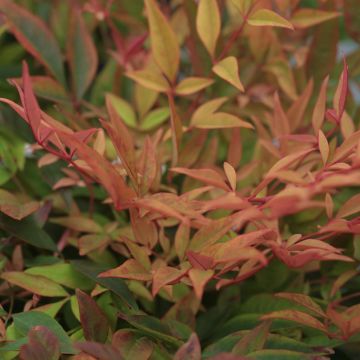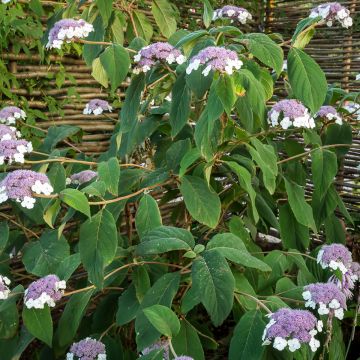

Nandina domestica Wood's Dwarf - Bambou sacré nain


Nandina domestica Wood's Dwarf - Bambou sacré nain


Nandina domestica Wood's Dwarf - Bambou sacré nain
Nandina domestica Woods Dwarf - Sacred Bamboo
Nandina domestica Wood's Dwarf
Sacred Bamboo, Heavenly Bamboo
Small bush received in very good condition, quite sturdy. I'll see in a few months if it lives up to its promises.
Florence, 01/04/2023
Special offer!
Receive a €20 voucher for any order over €90 (excluding delivery costs, credit notes, and plastic-free options)!
1- Add your favorite plants to your cart.
2- Once you have reached €90, confirm your order (you can even choose the delivery date!).
3- As soon as your order is shipped, you will receive an email containing your voucher code, valid for 3 months (90 days).
Your voucher is unique and can only be used once, for any order with a minimum value of €20, excluding delivery costs.
Can be combined with other current offers, non-divisible and non-refundable.
Home or relay delivery (depending on size and destination)
Schedule delivery date,
and select date in basket
This plant carries a 24 months recovery warranty
More information
We guarantee the quality of our plants for a full growing cycle, and will replace at our expense any plant that fails to recover under normal climatic and planting conditions.
Would this plant suit my garden?
Set up your Plantfit profile →
Description
Nandina domestica 'Wood's Dwarf' is a dwarf variety of sacred bamboo that stands out for its dense and beautifully rounded habit, as well as for its truly flamboyant autumn and winter colours. Its purplish-red young shoots unfold into green leaves composed of large leaflets that turn bright red with orange highlights in autumn and winter. Well-suited for small spaces and terrace decoration, this extremely decorative bush is easily grown in ordinary garden soil, even if very dry in summer.
'Wood's Dwarf' belongs to the Berberidaceae family. This small bush has a slow growth rate and its adult size will not exceed 1m (3ft) in height and 60cm (24in) in width after many years. Taller than wide, it forms a dense mass, supported by short stems resembling those of bamboo. It is beautiful throughout the year with evergreen foliage that changes colour, but this variety flowers infrequently and rarely produces fruits. When it does flower, it is in summer and appears as upright panicles adorned with small white flowers, sometimes followed by red berries. The leaves are divided into lanceolate leaflets, with barely noticeable ruffles. The root of this plant is a rhizome that can produce suckers, allowing it to spread somewhat in width.
Nandina domestica 'Wood's Dwarf' is particularly admirable in large plantings, along a path, or to dress the base of light-foliaged shrubs or trees. It can be paired with dwarf spireas (Spiraea japonica 'Little Princess'), colourful foliage Physocarpus ('Little Devil', 'Amber Jubilee', 'Dart's Gold'), Euphorbia griffithii 'Fire Glow', a Compact Winged Euonymus, or even dwarf Berberis 'Bagatelle'. Each of these scenes will be a success. This small bush will also be magnificent in a large pot on a terrace, in a non-burning exposure, and with regular watering.
Report an error about the product description
Nandina domestica Woods Dwarf - Sacred Bamboo in pictures


Plant habit
Flowering
Foliage
Botanical data
Nandina
domestica
Wood's Dwarf
Berberidaceae
Sacred Bamboo, Heavenly Bamboo
Cultivar or hybrid
Other Nandina
View all →Planting and care
Plant in soft, deep, well-drained, even slightly calcareous, moderately dry to moist soil. Once well-established, it will completely do without watering in summer. It prefers sunny but not scorching situations, or partial shade. Avoid drying winds and provide a location sheltered from severe cold. This bush is hardy down to -15°C (5°F) under optimal conditions, so it would be wise to protect its base with a thick layer of dead leaves before winter in the coldest regions. If the aboveground part were to freeze, the plant should be pruned back to ground level in February-March. Pruning is limited to removing dead wood and excess or weak branches in winter.
Planting period
Intended location
Care
-
, onOrder confirmed
Reply from on Promesse de fleurs
Similar products
Haven't found what you were looking for?
Hardiness is the lowest winter temperature a plant can endure without suffering serious damage or even dying. However, hardiness is affected by location (a sheltered area, such as a patio), protection (winter cover) and soil type (hardiness is improved by well-drained soil).

Photo Sharing Terms & Conditions
In order to encourage gardeners to interact and share their experiences, Promesse de fleurs offers various media enabling content to be uploaded onto its Site - in particular via the ‘Photo sharing’ module.
The User agrees to refrain from:
- Posting any content that is illegal, prejudicial, insulting, racist, inciteful to hatred, revisionist, contrary to public decency, that infringes on privacy or on the privacy rights of third parties, in particular the publicity rights of persons and goods, intellectual property rights, or the right to privacy.
- Submitting content on behalf of a third party;
- Impersonate the identity of a third party and/or publish any personal information about a third party;
In general, the User undertakes to refrain from any unethical behaviour.
All Content (in particular text, comments, files, images, photos, videos, creative works, etc.), which may be subject to property or intellectual property rights, image or other private rights, shall remain the property of the User, subject to the limited rights granted by the terms of the licence granted by Promesse de fleurs as stated below. Users are at liberty to publish or not to publish such Content on the Site, notably via the ‘Photo Sharing’ facility, and accept that this Content shall be made public and freely accessible, notably on the Internet.
Users further acknowledge, undertake to have ,and guarantee that they hold all necessary rights and permissions to publish such material on the Site, in particular with regard to the legislation in force pertaining to any privacy, property, intellectual property, image, or contractual rights, or rights of any other nature. By publishing such Content on the Site, Users acknowledge accepting full liability as publishers of the Content within the meaning of the law, and grant Promesse de fleurs, free of charge, an inclusive, worldwide licence for the said Content for the entire duration of its publication, including all reproduction, representation, up/downloading, displaying, performing, transmission, and storage rights.
Users also grant permission for their name to be linked to the Content and accept that this link may not always be made available.
By engaging in posting material, Users consent to their Content becoming automatically accessible on the Internet, in particular on other sites and/or blogs and/or web pages of the Promesse de fleurs site, including in particular social pages and the Promesse de fleurs catalogue.
Users may secure the removal of entrusted content free of charge by issuing a simple request via our contact form.
The flowering period indicated on our website applies to countries and regions located in USDA zone 8 (France, the United Kingdom, Ireland, the Netherlands, etc.)
It will vary according to where you live:
- In zones 9 to 10 (Italy, Spain, Greece, etc.), flowering will occur about 2 to 4 weeks earlier.
- In zones 6 to 7 (Germany, Poland, Slovenia, and lower mountainous regions), flowering will be delayed by 2 to 3 weeks.
- In zone 5 (Central Europe, Scandinavia), blooming will be delayed by 3 to 5 weeks.
In temperate climates, pruning of spring-flowering shrubs (forsythia, spireas, etc.) should be done just after flowering.
Pruning of summer-flowering shrubs (Indian Lilac, Perovskia, etc.) can be done in winter or spring.
In cold regions as well as with frost-sensitive plants, avoid pruning too early when severe frosts may still occur.
The planting period indicated on our website applies to countries and regions located in USDA zone 8 (France, United Kingdom, Ireland, Netherlands).
It will vary according to where you live:
- In Mediterranean zones (Marseille, Madrid, Milan, etc.), autumn and winter are the best planting periods.
- In continental zones (Strasbourg, Munich, Vienna, etc.), delay planting by 2 to 3 weeks in spring and bring it forward by 2 to 4 weeks in autumn.
- In mountainous regions (the Alps, Pyrenees, Carpathians, etc.), it is best to plant in late spring (May-June) or late summer (August-September).
The harvesting period indicated on our website applies to countries and regions in USDA zone 8 (France, England, Ireland, the Netherlands).
In colder areas (Scandinavia, Poland, Austria...) fruit and vegetable harvests are likely to be delayed by 3-4 weeks.
In warmer areas (Italy, Spain, Greece, etc.), harvesting will probably take place earlier, depending on weather conditions.
The sowing periods indicated on our website apply to countries and regions within USDA Zone 8 (France, UK, Ireland, Netherlands).
In colder areas (Scandinavia, Poland, Austria...), delay any outdoor sowing by 3-4 weeks, or sow under glass.
In warmer climes (Italy, Spain, Greece, etc.), bring outdoor sowing forward by a few weeks.


















































